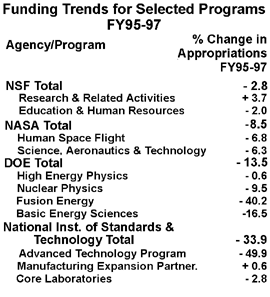The University Record, November 19, 1996
Research funding picture not as gloomy
but still needs work
The following is adapted from an article in the November issue of the DRDA Reporter.
By Bob Samors
U-M Washington, D.C., Office
If I had to think of one word to summarize the results of the fiscal year 1997 (FY97) federal appropriations process as it pertains to research, I would use the term “mixed.” This choice of word comes after reviewing the individual funding bills and several analyses prepared by people who make a living crunching numbers.
Admittedly, my assessment may put me in something of a minority position as the research community is constantly being told that we should feel good about the overall increase in FY97 federal research and development funding (which the American Association for the Advancement of Science [AAAS] pegs at 4.1 percent) since the scenario laid out in Congressional budgets two years ago called for overall, double digit reductions.
I, for one, do not share in this enthusiasm, nor do I think the research community as a whole should be particularly pleased either. Now, before anyone accuses me of whining and just demanding “more more more,” allow me to explain my point of view.
Certainly, there are several true bright spots in the FY97 appropriations cycle, according to an AAAS analysis, including:
¤¤¤The National Institutes of Health (NIH), which received a 6.9 percent increase in its research budget over FY96.
¤¤¤The Environmental Protection Agency, whose research account received a 12.3 percent increase.
¤¤¤The Department of Commerce research and development account, which received a 7.7 percent increase.
 Yet, beyond those stellar results, the major basic research accounts are either only slightly above last year and barely keeping pace with inflation—National Science Foundation Research and Related Activities and the Department of Energy, for example. Funding for research accounts in NASA and the Department of Defense actually declined fairly significantly from their FY96 levels. Keep in mind, these result occurred in an election year when Congress and the Administration were trying hard to support their various priority areas and avoid controversy.
Yet, beyond those stellar results, the major basic research accounts are either only slightly above last year and barely keeping pace with inflation—National Science Foundation Research and Related Activities and the Department of Energy, for example. Funding for research accounts in NASA and the Department of Defense actually declined fairly significantly from their FY96 levels. Keep in mind, these result occurred in an election year when Congress and the Administration were trying hard to support their various priority areas and avoid controversy.
The point of my analysis is to suggest that we have a lot of work to do in the future. Granted, the overall results for research funding have not been as gloomy as once predicted. However, except for NIH, a number of research programs have been hit quite hard, while others are barely keeping pace with inflation. The recent AAAS analysis concluded that between FY94 and FY97, federal support for research and development has actually declined by almost 2 percent in real terms.
Further, balanced budget plans put forward by both presidential candidates and the majority in Congress suggest nothing less than a continuation of this situation, if not worse. In the absence of entitlement reform, any serious effort to balance the federal budget will be done on the back of the non-defense discretionary budget, which is the source of the bulk of research funding. I do not believe that the outcome of the election will have a significant impact on Washington’s attitude toward federal support for research.
So, then, what can we do? Clearly, vigilance is a necessity, education is imperative, but more than that will be required. We must find ways (that’s plural—there’s no “silver bullet”) to convince decisionmakers in Washington that support for research resulting in real growth, not just inflation increases, must be a priority for the state and the country. The research community has helped to mitigate some of the worst-case scenarios projected a couple of years ago, but we have no laurels to rest on because we are still in a deficit situation.
In the October issue of Biomedical News, Irwin Goldstein, associate dean for research at the Medical School, characterized the situation we face as follows:
“We must ask ourselves hard questions about funding percentiles and paylines, and our ability to support students and technical staff. Have we achieved or maintained forward momentum, instead of running in place? It would be short-sighted to attribute any problems to any one party or elected official, but what those questions should make each of use realize is that the assumption of continued funding stability is no longer realistic. It depends on each of us, more than ever, for continued advocacy.”
Well said, Irwin.

